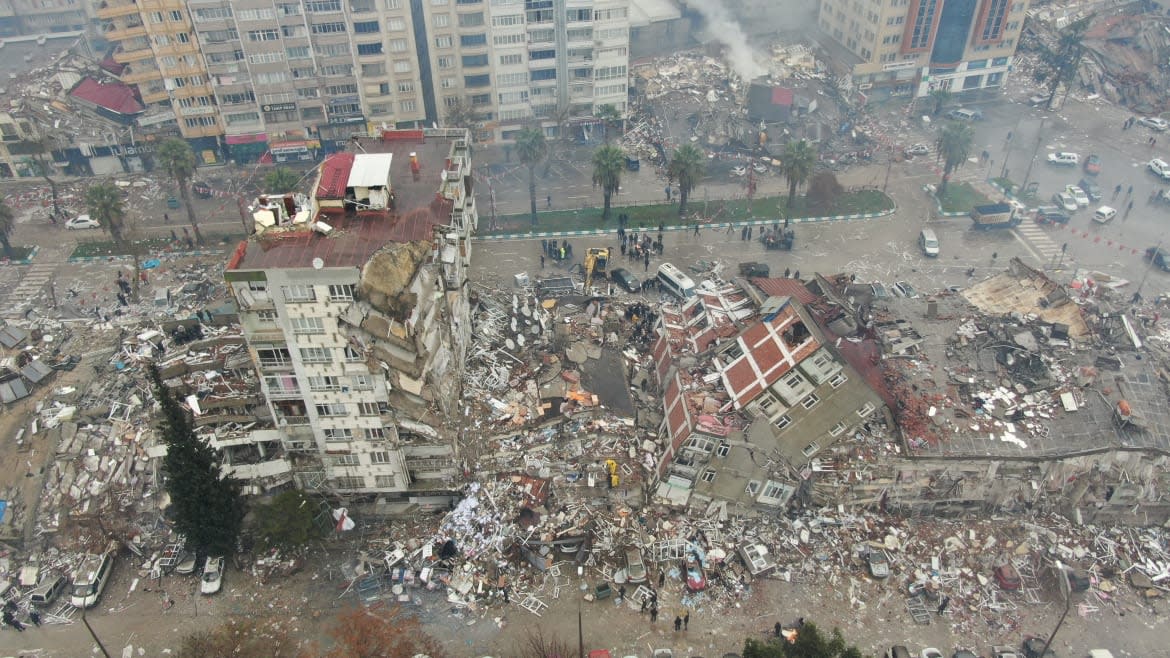Earthquake Aftershocks May Devastate Turkey and Syria for Many Months

A magnitude 7.8 earthquake that hit Turkey and Syria early Monday morning has set off a cascade of destruction, as strong aftershocks have buffeted the region and killed thousands.
A magnitude 6.7 aftershock followed the first tremor at around 4 am local time; then, nine hours later, another massive shock measured to be a magnitude 7.5 struck the north, which was followed by smaller aftershocks. These aftershocks are devastating in their own right, causing buildings to collapse and knocking down an ancient Roman castle, putting people in constant danger. And unfortunately, this may be just a taste of what the region will contend with for many, many more months.
“The number of aftershocks will decrease with time, but large events can continue to occur, for months or longer,” Jascha Polet, a geophysics researcher at Cal Poly Pomona, tweeted Monday morning. And experts on social media and in the press conveyed similar sentiments.
This animation shows the series of earthquakes that have just occurred in Turkey. The initial M7.8 mainshock was followed by a M6.7 aftershock, and many smaller aftershocks. Nine hours after the M7.8 quake occurred, a M7.5 quake struck to the north, followed by more aftershocks. pic.twitter.com/kUReRRNz9N
— EarthScope Consortium (@EarthScope_sci) February 6, 2023
According to the U.S. Geological Survey, the region in which the quake occurred is seismically active, yet only three other quakes of magnitude 6 or above have hit the area since 1970—most recently, a magnitude 6.7 earthquake that killed dozens and injured thousands in 2020. A magnitude 7.0 earthquake hit Aleppo, Syria in 1822 and killed tens of thousands of people. Aftershocks were felt up to a year later.
To understand why the region could be in danger for such a long time after the initial event, we have to unpack how the earthquake occurred in the first place. The region sits on top of what’s called the East Anatolian Fault, a strike-slip fault defined as two blocks of rock sliding past one another. People who live around the Pacific Ocean should already be familiar—the infamous San Andreas Fault is another example of this kind of fault.
Judith Hubbard, a structural geologist at Nanyang Technological University in Singapore, explained on Twitter that as the Arabian Plate collides with the Eurasian Plate to its north, the Anatolian Block squeezes out westward, “like a watermelon seed out from your fingers.” The East Anatolian Fault lies at the intersection between the Anatolian Block and Arabian Plate, which are moving about 15 millimeters relative to each other per year, stretching the Earth’s crust across the fault.
Second Century Roman Castle Destroyed in Deadly Earthquake
“The tectonic movement between earthquakes is slow but the ‘catching up’ isn’t—that snapping motion is what causes the seismic energy to emanate out from the fault, causing the Earth to quake,” Hubbard wrote.
Major earthquakes are usually followed by hundreds or thousands of aftershocks that occur along and adjacent to the fault displaced during the mainshock, according to the Incorporated Research Institutions for Seismology Consortium.
“With rare exceptions, all magnitude 7 to magnitude 9 earthquakes have a collection of smaller aftershocks that can occur for weeks, years, or even centuries after the mainshock,” the consortium said in a 2019 video.
Thousands Feared Dead in Massive Overnight Earthquake
The ‘mainshock’ of an earthquake represents two tectonic plates overcoming friction to slip past one another. In contrast, aftershocks typically represent “minor readjustments along the portion of a fault that slipped at the time of the mainshock,” according to USGS, which is now listing nearly 60 aftershocks in the region since Monday morning. In Turkey, it seems like some of these aftershocks are not occurring along the same fault line as the mainshock, but rather one splaying off it.
Another important factor is depth: Shallow earthquakes are much more likely to cause aftershocks than ones that occur more than 18 miles underground. The mainshock of this earthquake occurred about 10.5 miles underground, Curtin University Earth and planetary sciences researcher Chris Elders told Al Jazeera English.
The full scope of the disaster has yet to be realized. There are still many people to be rescued, and many more who will be at risk as more aftershocks hit the region in the weeks and months to come.
Get the Daily Beast's biggest scoops and scandals delivered right to your inbox. Sign up now.
Stay informed and gain unlimited access to the Daily Beast's unmatched reporting. Subscribe now.

